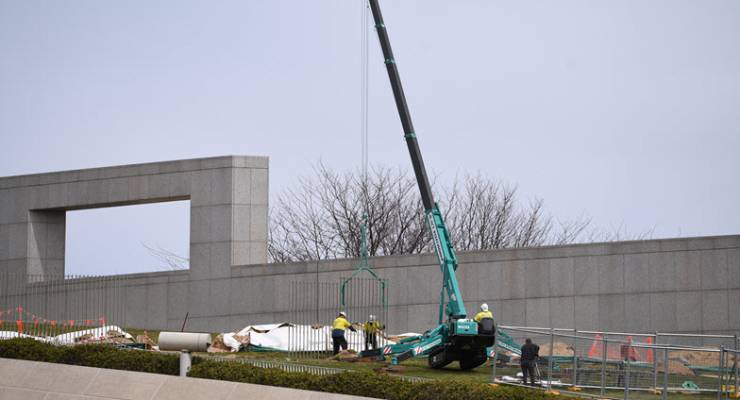
On Tuesday, September 12, 2017, as postal survey ballots concerning marriage equality were arriving in the mailboxes of voters across the country, another (less well publicised) example of where democracy was at in Australia could be spotted under construction in the nation’s capital: a big ol’ security fence around the lawns of Parliament House.
In November of 2016, on the last sitting day of the year, 40 pro-refugee protesters glued themselves to a banister in the House of Representatives’ chamber, chanting “close the camps” and “bring them here”. They were forcibly ejected and legislation was rushed through the same day approving the building of a 2.6-metre perimeter fence around the house lawns. The fence has been called part of “an authoritarian ‘Fortress Australia’ approach”, but a 2014 parliamentary report was damning, citing numerous ways our house of democracy is insufficiently safe.
So, how did we get here?
The new Parliament House was completed in 1988, and was initially fairly lax with security; until 2003, MPs were not required to go through security screening. Slowly, the growing concerns about terrorism and, more often, troublesome protests led to incremental increases in security and reductions in public accessibility.
The issue of preventing ram-raid attacks pre-dates the recent trend of terrorist attacks utilising cars and vans. In August 1992, a man crashed his 4WD (which contained a shotgun and shells) through the Parliament entrance, and got all the way to Great Hall before his car stalled. Four concrete bollards were installed as a result.
But serious increases in the security around Parliament didn’t entirely commence until post 9/11. A wall was built around the house to prevent vehicles being driven onto the house roof, and the ministers’ windows were bomb-proofed — although the 2014 report did find several troubling gaps in bomb- and bullet-proofing across the house — and retractable bollards were installed at all house entrances. This commenced in 2005 — and while we don’t know for sure if it thwarted or dissuaded specific attacks, it definitely caused vehicles troubles. A Senate estimates hearing in 2006 heard that, due to malfunctions, the bollards had trapped politicians in their cars, trapped trucks and, in two particularly hair raising instances, had lifted a landscaping cart into the air, and later impaled the undercarriage of a slow-moving tractor.
In 2009, the analogue CCTV cameras were replaced with digital cameras. In the 2011-2012 budget, a further $18.3 million was directed to the Department of Parliamentary Services, which conducts the security in Parliament House, for, among other things, additional staffing.
Details on the most recent security upgrade are sketchy, at best. The exact costs and information about the fence in general have been hard to come by for journalists, with public servants and the two speakers Tony Smith (lower) and Stephen Parry (upper) reluctant to release the information, or even consult with the public, due to (what else) “security reasons”. This has led to “deep concerns” from the Australian Institute of Architects, who demanded an urgent review be undertaken.
It speaks volumes that the rumour that eye-sore soothing foliage will adorn the fence appears to have been given to Fairfax off the record.








You Turkeys out there, “Keep calm and keep keeping on”.
We are supreme beings and will protect our chicken hearted selves at any cost to the maximum level available.
Parliament House or Cowards Castle?
“And bollards to you!
“This is typical. Absolutely typical…of the kind of…arse I have to put up with from you people. You ponce in here expecting to be listend too, while I’m trying to run a government here. Have you any idea of how much there is to do? Do you ever think of that? Of course not, you’re all too busy sticking your noses into every corner, poking around for things to complain about, aren’t you? Well let me tell you something – this is exactly how Nazi Germany started. A lot of layabouts with nothing better to do than to cause trouble. Well I’ve had thirteen years and three months of pandering to the likes of you, and I’ve had enough. Get out – and stay out.
“What will you be expecting next? Increased safety around schools, rather than around this usually largely underoccupied edifice? This monument to tax-payer funded politician’s self-indulgence?
“Where’s Andrew Laming ….?”
[Basil Turnbull]
“Malcolm Fawlty”(?) ….. and moderation?
Five and a half hours in moderation?????
Had to be checked over by The Bureau of State Security, I reckon.
Watch out for blokes in trilby hats and flasher raincoats lurking in your street K .
No problem . . . just put locks on outside so we can be sure they can’t do any more damage to rest of the nation.
The useless bunch would start tweeting, and still cause problems.
I do like your idea tho.
The political equivalent of Granpa Simpson yelling “get orf my lawn!”.
Hell, we only paid for it and the continuing largesse of the salaries & perks.
Cheek!